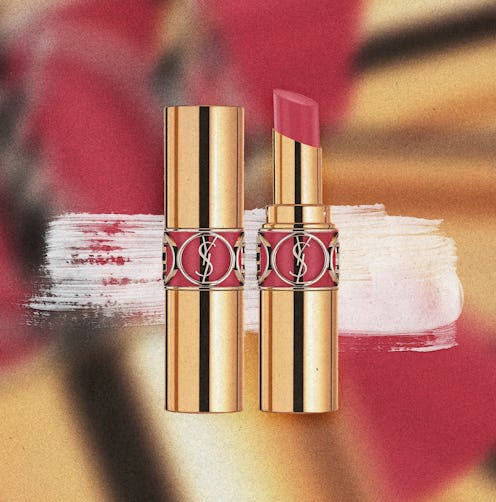(Cult Status)
YSL’s Rouge Volupté Shine Walked So Lip Oils Could Run
Here’s what makes it a modern classic.

Cult Status is our series that highlights an iconic item from brands both established and buzz-worthy. In these features, you'll discover the fascinating history of how one extra-special piece exceeded expectations and became a forever product. This time, the focus is on YSL Beauty’s Rouge Volupté Shine.
TikTok has spoken — thick, gooey glosses are out and smooth, shiny lip oils are in. Since the lockdown of 2020, the nostalgia-fueled rise of Y2K beauty trends and products have continued to dominate the clock app, with lip oils at the forefront. While the initial draw to the looks of the early aughts was their tie to a simpler, carefree time, shiny tinted lips are still having a moment in 2023 because they’re in line with the universal shift from heavy makeup to lightweight, skin care-infused formulas (think skin tints and cream blush). While a number of options have flooded virtual and physical shelves in the last few years, YSL Beauty’s Rouge Volupté Shine continues to stand out and hold up as a cult-classic.
Unlike the literal oils that come with a doefoot applicator, this product uniquely combines the high-shine of an oil, moisturizing properties of a balm, and color payoff of a satin lip formula in a solid stick. Housed in a luxurious gold tube with the YSL emblem embossed on it, Rouge Volupté Shine is easy to find when you’re digging through your bag and an item you want to show off on your vanity. Not to mention, the unique lipstick format allows for mess-free application.
Originally launched in 2013, nearly a decade before the TikTok lip oil craze, Rogue Volupté Shine comes in 30 shades, ranging from cherry red to tawny nude, and every staple color in-between. (The brand regularly updates its shade offerings.) For spring/summer 2023, YSL added eight nudes to the lineup — browns, beiges, and pinks — so every skin tone can have their perfect neutral lip moment.
In addition to keeping a finger on the pulse of color trends, YSL’s Rouge Volupté Shine remains relevant thanks to innovation. In a landscape where naturally-derived ingredients have become table stakes, the brand has begun to revamp some of its iconic products to include sustainably-sourced botanicals from Ourika Gardens, a co-op run by local women in Marrakesh, Morocco, who lead the harvest, farming practices, and directly profit from their crops. This is an operation I was able to witness firsthand on a tour of the garden with the brand.
During my time there, Caroline Negre, YSL Beauty's Global Sustainability & Scientific Director shared that the botanicals species are harvested and alternated based on the season. If previously unused in one of YSL’s formulas, research is conducted on them in a lab to determine what cosmetic benefits they may harness for future products.
The process between planting the initial seed and developing the product takes about four years. “There are more than 200 different botanical species in the garden, so the first step is figuring out what’s going to grow here,” Negre says. “While the plant is growing, we work to identify the key molecules in the plant and then we work with labs to to determine the right extraction process that will capture most of the molecules. Then we collect potential ingredients, verify the efficacy, start the crop process, and then produce the product.”
In Rouge Volupté Shine specifically, the pomegranate extract comes from the gardens, which the brand says was chosen because it’s a powerful hydrator. Combined with other actives, including macademia butter and 65% essential oils, the formula glides on for even medium coverage with a high-shine finish and conditions lips so they’re soft and smooth throughout the day — even if a bit wears off as you chug a morning coffee (or two).
“The pomegranate is dried then sent to France where the molecule is extracted and stabilized, and then it’s shipped to the factory for production,” Negre says of the botanical, noting that Rouge Volupté Shine was the first makeup product to be reformulated with a botanical from the garden.
The addition of newly-sourced botanical ingredients to YSL’s formulas looks to the future of responsible ingredient hravesting in the light of the beauty industry’s role in climate change, but the Ourika Gardens is also a nod to the French fashion house’s legacy. Late designer Yves Saint Laurent had a lifelong love affair with Marrakesh. On his first visit to the Pink City with partner Pierre Bergé, he fell in love with its colors and lush landscapes, including the intoxicating scents, such as jasmine, which the brand uses in other products like the best-selling All Hours Foundation. In 1980, the couple purchased a second home in Marrakesh, a historic estate from Jacques Majorelle, which served as a sanctuary for YSL between collection presentations in Paris and a means of inspiration. He often sketched upcoming designs from an attic studio in the house.
Outside of the gardens and YSL’s Moroccan haven, the brand is further supporting the regions from which it derives ingredients through its partnership with Re:Wild, a conservation organization. Working with local farming communities, the goal is to restore 100,000 hectares of land in the Ourika Valley by 2030. This includes planting olive trees in the Atlas Mountains and efforts to prevent erosion in the region.
Some may consider nostalgia an illness, but looking to the past can payoff by driving innovation forward. Consider the revamped Rouge Volupté Shine, which combines the high-shine lips of the early aughts with eco-friendly ingredient sourcing principles, a prime example.